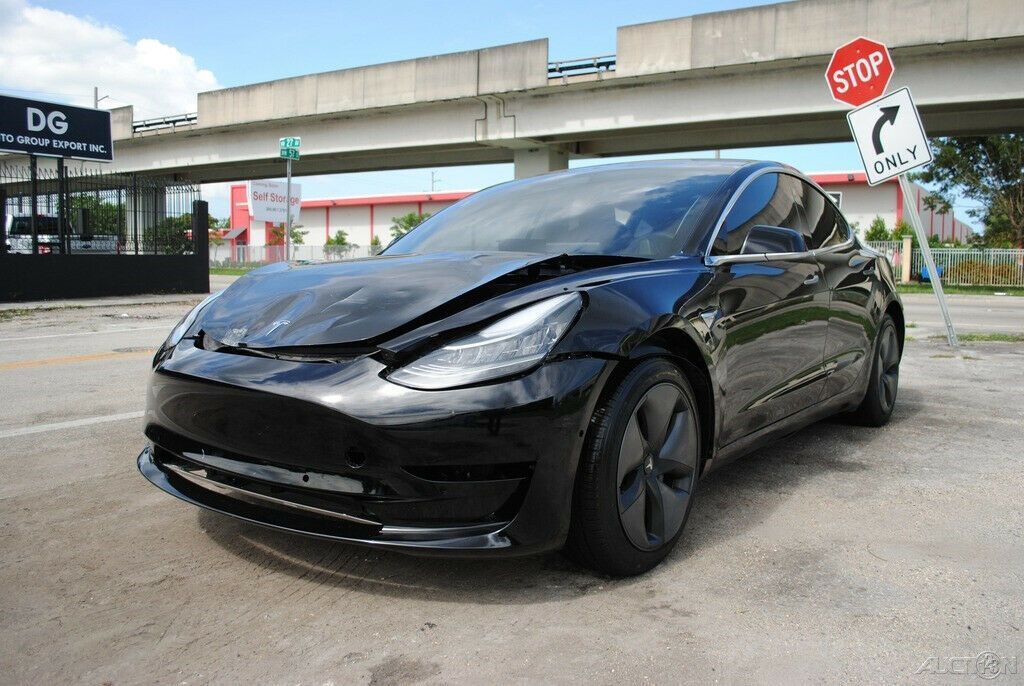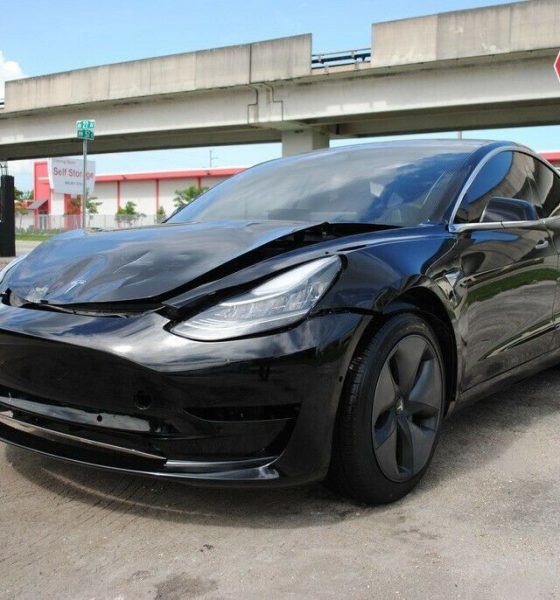

News
Tesla Model 3 buyer pays the price after inadvertently buying a resold wrecked unit
A Tesla enthusiast who purchased a second-hand Model 3 from a Florida car dealership website has paid a steep price after his vehicle turned out to be a previously totaled unit. This was despite the Model 3 being sold on the second-hand market as a clean title vehicle, and the fact that its Carfax report did not raise any red flags.
Luke Jackson, the Tesla enthusiast, told Channel 2 Action News that the Model 3 had been his dream car, and that he had saved up for the vehicle so that he could buy it in cash. When he saw the car being offered online, it looked like he had found the perfect second-hand Model 3. “The title looked clean. There’s only 9000 miles on it. It was a 2018. So perfect scenario,” Jackson told the news agency.
It took months before Jackson was made aware of his car’s true history. As it turned out, the Model 3 had been declared a total loss last year after suffering extensive front-end damage. It was later sold on an auto auction website where it was listed with an estimated repair cost of $34,000. Yet despite this, the Model 3 still had its original title, and it was not branded as salvaged when Jackson purchased it.
Channel 2 Action News noted that Jackson’s second-hand Model 3 is related to an investigation that it published back in September. During that time, the news site featured the story of a second-hand 2015 Toyota 4-Runner that has changed hands at least seven times over the last five years in five separate states. The whole time, the SUV had missing side airbags, a critical safety issue that none of its buyers knew about.
Jackson’s Model 3 and the safety-compromised 4-Runner had something in common. Both vehicles got their clean titles in Texas, and everything about it was legal. This is because Texas law has a 100% “total loss threshold,” which meant that unless a vehicle’s repair cost is more than what the car is worth, the title would remain original. This particular law effectively conceals the history of cars to a point, especially those that were involved in serious accidents.
Chris Humphries, one of the 4-Runner’s previous owners, has taken it upon himself to do some more digging on why such unsafe vehicles are being sold. Eventually, he noticed a pattern, which he shared with the news agency. A good number of the damaged vehicles for sale in Texas were listed under the same seller name: Progressive Insurance. The name of the seller was eventually hidden on the auto auction website, but not before Humphries was able to take screenshots of the listings.
When contacted by Channel 2 Action News, Progressive Insurance noted that it was following the laws and regulations set forth by Texas law. “We follow the laws and regulations set forth by the applicable state and are extremely confident we were in compliance with the Texas state law,” the firm responded.
The damaged Toyota 4-Runner emerged once more in November, this time in Nashville. Humphries noted that the SUV’s new owner actually has children who are riding in the backseat despite the vehicle not having any side airbags. The Model 3 owner, for his part, ended up losing his warranties when Tesla found out about his car’s history. As of date, the second-hand Model 3’s Supercharger access had been disabled as well.
“If I were to resell it, the value would be cut in half probably. Because it’s not under car warranty. They’re going to know now that it was salvaged. So I kind of just lost $20,000,” the Tesla enthusiast said.
Channel 2‘s report on the story could be found here.

Elon Musk
Elon Musk’s X will start using a Tesla-like software update strategy
The initiative seems designed to accelerate updates to the social media platform, while maintaining maximum transparency.

Elon Musk’s social media platform X will adopt a Tesla-esque approach to software updates for its algorithm.
The initiative seems designed to accelerate updates to the social media platform, while maintaining maximum transparency.
X’s updates to its updates
As per Musk in a post on X, the social media company will be making a new algorithm to determine what organic and advertising posts are recommended to users. These updates would then be repeated every four weeks.
“We will make the new 𝕏 algorithm, including all code used to determine what organic and advertising posts are recommended to users, open source in 7 days. This will be repeated every 4 weeks, with comprehensive developer notes, to help you understand what changed,” Musk wrote in his post.
The initiative somewhat mirrors Tesla’s over-the-air update model, where vehicle software is regularly refined and pushed to users with detailed release notes. This should allow users to better understand the details of X’s every update and foster a healthy feedback loop for the social media platform.
xAI and X
X, formerly Twitter, has been acquired by Elon Musk’s artificial intelligence startup, xAI last year. Since then, xAI has seen a rapid rise in valuation. Following the company’s the company’s upsized $20 billion Series E funding round, estimates now suggest that xAI is worth tens about $230 to $235 billion. That’s several times larger than Tesla when Elon Musk received his controversial 2018 CEO Performance Award.
As per xAI, the Series E funding round attracted a diverse group of investors, including Valor Equity Partners, Stepstone Group, Fidelity Management & Research Company, Qatar Investment Authority, MGX, and Baron Capital Group, among others. Strategic partners NVIDIA and Cisco Investments also continued support for building the world’s largest GPU clusters.
News
Tesla FSD Supervised wins MotorTrend’s Best Driver Assistance Award
The decision marks a notable reversal for the publication from prior years, with judges citing major real-world improvements that pushed Tesla’s latest FSD software ahead of every competing ADAS system.

Tesla’s Full Self-Driving (Supervised) system has been named the best driver-assistance technology on the market, earning top honors at the 2026 MotorTrend Best Tech Awards.
The decision marks a notable reversal for the publication from prior years, with judges citing major real-world improvements that pushed Tesla’s latest FSD software ahead of every competing ADAS system. And it wasn’t even close.
MotorTrend reverses course
MotorTrend awarded Tesla FSD (Supervised) its 2026 Best Tech Driver Assistance title after extensive testing of the latest v14 software. The publication acknowledged that it had previously criticized earlier versions of FSD for erratic behavior and near-miss incidents, ultimately favoring rivals such as GM’s Super Cruise in earlier evaluations.
According to MotorTrend, the newest iteration of FSD resolved many of those shortcomings. Testers said v14 showed far smoother behavior in complex urban scenarios, including unprotected left turns, traffic circles, emergency vehicles, and dense city streets. While the system still requires constant driver supervision, judges concluded that no other advanced driver-assistance system currently matches its breadth of capability.
Unlike rival systems that rely on combinations of cameras, radar, lidar, and mapped highways, Tesla’s FSD operates using a camera-only approach and is capable of driving on city streets, rural roads, and freeways. MotorTrend stated that pure utility, the ability to handle nearly all road types, ultimately separated FSD from competitors like Ford BlueCruise, GM Super Cruise, and BMW’s Highway Assistant.
High cost and high capability
MotorTrend also addressed FSD’s pricing, which remains significantly higher than rival systems. Tesla currently charges $8,000 for a one-time purchase or $99 per month for a subscription, compared with far lower upfront and subscription costs from other automakers. The publication noted that the premium is justified given FSD’s unmatched scope and continuous software evolution.
Safety remained a central focus of the evaluation. While testers reported collision-free operation over thousands of miles, they noted ongoing concerns around FSD’s configurable driving modes, including options that allow aggressive driving and speeds beyond posted limits. MotorTrend emphasized that, like all Level 2 systems, FSD still depends on a fully attentive human driver at all times.
Despite those caveats, the publication concluded that Tesla’s rapid software progress fundamentally reshaped the competitive landscape. For drivers seeking the most capable hands-on driver-assistance system available today, MotorTrend concluded Tesla FSD (Supervised) now stands alone at the top.
News
Elon Musk’s Grokipedia surges to 5.6M articles, almost 79% of English Wikipedia
The explosive growth marks a major milestone for the AI-powered online encyclopedia, which was launched by Elon Musk’s xAI just months ago.

Elon Musk’s Grokipedia has grown to an impressive 5,615,201 articles as of today, closing in on 79% of the English Wikipedia’s current total of 7,119,376 articles.
The explosive growth marks a major milestone for the AI-powered online encyclopedia, which was launched by Elon Musk’s xAI just months ago. Needless to say, it would only be a matter of time before Grokipedia exceeds English Wikipedia in sheer volume.
Grokipedia’s rapid growth
xAI’s vision for Grokipedia emphasizes neutrality, while Grok’s reasoning capabilities allow for fast drafting and fact-checking. When Elon Musk announced the initiative in late September 2025, he noted that Grokipedia would be an improvement to Wikipedia because it would be designed to avoid bias.
At the time, Musk noted that Grokipedia “is a necessary step towards the xAI goal of understanding the Universe.”
Grokipedia was launched in late October, and while xAI was careful to list it only as Version 0.1 at the time, the online encyclopedia immediately earned praise. Wikipedia co-founder Larry Sanger highlighted the project’s innovative approach, noting how it leverages AI to fill knowledge gaps and enable rapid updates. Netizens also observed how Grokipedia tends to present articles in a more objective manner compared to Wikipedia, which is edited by humans.
Elon Musk’s ambitious plans
With 5,615,201 total articles, Grokipedia has now grown to almost 79% of English Wikipedia’s article base. This is incredibly quick, though Grokipedia remains text-only for now. xAI, for its part, has now updated the online encyclopedia’s iteration to v0.2.
Elon Musk has shared bold ideas for Grokipedia, including sending a record of the entire knowledge base to space as part of xAI’s mission to preserve and expand human understanding. At some point, Musk stated that Grokipedia will be renamed to Encyclopedia Galactica, and it will be sent to the cosmos.
“When Grokipedia is good enough (long way to go), we will change the name to Encyclopedia Galactica. It will be an open source distillation of all knowledge, including audio, images and video. Join xAI to help build the sci-fi version of the Library of Alexandria!” Musk wrote, adding in a later post that “Copies will be etched in stone and sent to the Moon, Mars and beyond. This time, it will not be lost.”








